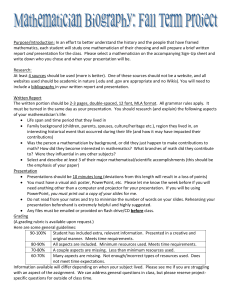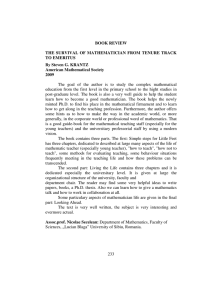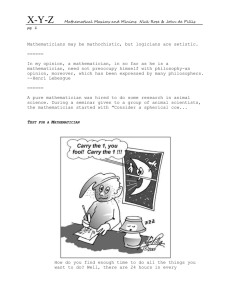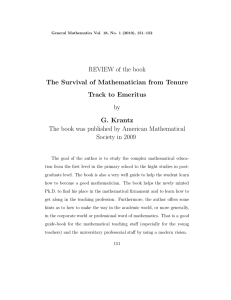10 Ways To Think Like A Mathematician Kevin Houston
advertisement
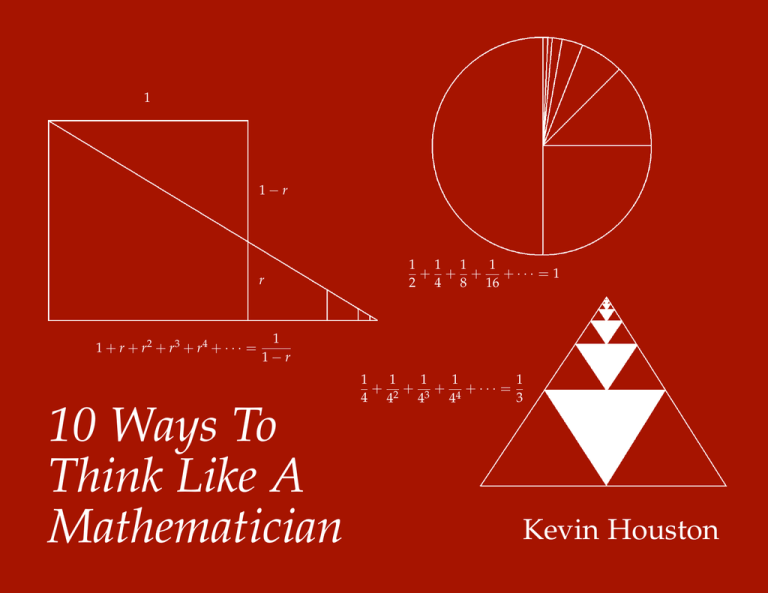
1 1−r r 1 + r + r2 + r3 + r4 + · · · = 1 1 1 1 + + + +··· = 1 2 4 8 16 1 1−r 10 Ways To Think Like A Mathematician 1 1 1 1 1 + 2 + 3 + 4 +··· = 4 4 3 4 4 Kevin Houston Get copies of this booklet at www.kevinhouston.net My mission Learning mathematics is hard. But I believe – very strongly – that if you can think like a mathematician, then the learning process is easier. So, my mission is to teach each student to think like a mathematician. As its title suggests this booklet gives ten such ways. In fact, it is a taster for my bestselling book for students: How to Think Like a Mathematician. If you want to avoid rote learning and instead really understand mathematics, then this book is for you. You can buy it at Amazon.com, Amazon.co.uk, Cambridge University Press, and many other bookshops. Sample chapters for the book can be found at www.kevinhouston.net and videos can be found on YouTube www.youtube.com/user/drkevinhouston. I hope this booklet inspires you. Let me know if it does. I’d love to hear from you. My contact details are on the back page. Please distribute this booklet! This booklet is free. And you are free to distribute the electronic file via email or store it in any electronic depository that takes your fancy. You are free to put the file on your blog, website or forum. If you are an educator, then feel free to include the booklet in introductory material for your students, eg in hard copy, or on a CD or pen drive. Print as many copies of this booklet as you like. You are free to stick the pages on your wall, distribute them on the streets, and so on. You are free to do all this on the condition that you do not change the contents or sell the booklet. Thanks! Kevin Houston Leeds, England September 2010 Buy the bestselling How to Think Like a Mathematician by Kevin Houston at any good bookshop Get copies of this booklet at www.kevinhouston.net Question everything 1 For me one of the truly great beauties of mathematics is that it can be checked. You don’t have to take anyone’s word. If someone says something is true, then you can ask them to prove it. Better still, if you want to really think like a mathematician, then you can try to prove it. Don’t let people spoon feed you! Your reaction to someone’s statement should be to disbelieve them and attempt to find an example that shows it’s false. Even if it’s true, the mental workout that this process gives is beneficial. It also helps develop a feel for a statement. (Note that constantly doing this in real life situations can lose you friends - people tend to get upset if you are constantly finding fault with what they say!) A letter to a newspaper stated that time travel is impossible because of logic: If time travel were possible, then one would meet lots of people from the future. I had some ideas why this might be wrong. Maybe time travel will only allows us to travel forward in time (by amounts larger than we do already!) Maybe time travellers are not allowed to communicate with us. Maybe time travel has a range, you can’t travel back more than a year and time travel is still a number of years away (and time travel machines can’t be transported). For more see page 93 of How to Think Like a Mathematician Get copies of this booklet at www.kevinhouston.net Write in sentences 2 Write in sentences? How is that going to help me think like a mathematician, you may be asking. Well, sentences are the building blocks of arguments. And higher-level mathematics is about arguments in the form of proof (not just about getting the right numerical answer!) . Too often students don’t see the need for sentences. They often say things like ‘I didn’t come to university to write essays’, ‘But I got the right answer’ or ‘You know what I meant’. In the past they could submit a collection of unconnected symbols as homework and still achieve almost full marks. But if you want to understand mathematics and to think clearly, then the discipline of writing in sentences forces you to think very carefully about your arguments. If you can’t write the sentence properly, then probably you don’t truly understand what you are writing about. That’s a great opportunity to learn more and develop your skills. And writing well in any subject is a useful skill to possess. [Bonus: One easy way to improve your mathematical writing and thinking is to know how to use the implication symbol =⇒ properly. See pages 37-38 and Part II of How to Think Like a Mathematician.] For more see Chapters 3 and 4 of How to Think Like a Mathematician Get copies of this booklet at www.kevinhouston.net ‘What about the converse?’ 3 Statements of the form A =⇒ B are at the heart of mathematics. We can also state this as ‘If A is true, then B is true.’ The converse of the statement ‘A =⇒ B’ is ‘B =⇒ A.’ For example, the converse of ‘If I am Winston Churchill, then I am English’ is ‘If I am English, then I am Winston Churchill.’ This simple example shows that even if a particular statement is true, then its converse need not true. It may be true or it may not be true. Investigation is required before we can say. A good mathematician, when presented with an A implies B type statement, will ask ‘Is the converse true?’ Internalize this question and make it part of your tool kit for doing mathematics. Whether the converse is true or not is not too important, the point is that the exercise sharpens mathematical ability. [By the way, as an aside, a big mistake people make when A =⇒ B is that they think that if A is not true, then B is not true either. That’s not right, the statement only says what happens when A is true. It says nothing about what happens when A is false. Now think like a mathematician and give an example!] For more see Chapter 9 of How to Think Like a Mathematician Get copies of this booklet at www.kevinhouston.net Use the contrapositive 4 The contrapositive of the statement ‘A =⇒ B’ is ‘ not( B) =⇒ not( A)’. For example, • ‘If I am Winston Churchill, then I am English’ has contrapositive ‘If am not English, then I am not Winston Churchill’. • ‘I am not American implies that I am not a Texan’ has contrapositive ‘If I am a Texan, then I am American’. • ‘x2 − 4x − 5 = 0 =⇒ x ≥ −2’ has contrapositive ‘x < −2 =⇒ x2 − 4x − 5 6= 0’. Surprisingly the truth of the contrapositive is the same as the truth of A =⇒ B! That is, if A =⇒ B is true, then not( B) =⇒ not( A) is true and vice versa. Check this in the examples above. This is very hard to get your head round the first time you meet it – most people don’t believe it. In fact, there is a famous education experiment connected to the idea of the contrapositive which is called Wason’s selection task. Look it up and see if you can pass the test! Less than 10% get it right. Because it is often used in proofs and because our everyday reasoning gets the contrapositive wrong you should learn it well. For more see pages 72-74 and Chapter 26 of How to Think Like a Mathematician Get copies of this booklet at www.kevinhouston.net Consider extreme examples 5 When given a theorem apply it to trivial and extreme examples of the objects in the assumptions. What happens if a particular number is 0 or 1? What happens if we take the trivial function defined by f ( x ) = 0? What happens if we take the empty set? What if we take a trivial sequence like 1, 1, 1, 1, 1, . . . ? What happens to the circle or line? These examples help sharpen understanding. They often give a clearer picture of where the theorem applies. As an extreme example consider the statement ‘y = x2 and z = y2 , so z 6= x2 .’ This is seems plausible as y and y2 are generally different, but it is not true. Consider y = 1. This occurs when x = 1. Use an extreme case to show that the following is false: ‘Theorem’: Suppose that a, b, c and d are integers. If ab = cd and a = c, then b = d. To use extreme examples you need a large stock of examples, so you will need to collect them and have them at your fingertips. One way of doing this is to imagine what you would say when someone wakes you up in the middle of the night and says ‘Quick it’s an emergency, give me a good example of an X’ where X is some mathematical object like a group, a vector space, a function, etc. [By the way, in general, you should also consider standard examples and non-examples. See pages 106-107 of the book.] For more see pages 112 and 123 of How to Think Like a Mathematician Get copies of this booklet at www.kevinhouston.net Create your own examples 6 A real mathematician creates their own examples, whether standard examples, extreme examples or non-examples! Let’s look at worked examples (i.e., examples of processes, algorithms, etc.). Consider the standard presentation of maxima and minima of functions in the study of calculus. We define first how a function is to be differentiated. Then singular points are defined as points where the derivative is zero. Next we are told that there are 3 types of singular point: maxima, minima and inflection. It is then shown that the second derivative of the function determines the type. After this examples are shown: here’s a function, here is where it has singular points, this is the type of singular point. The process is easy, differentiate f , solve f 0 ( x ) = 0, differentiate to get f 00 ( x ) and use the sign of f 00 ( x ) to find the type of singular point. This is the standard method of using worked examples. If you learn the method, then given a function you can easily find the maxima and minima. But what if I turn it around and ask you to create a function f of the variable x with a maximum at x = 2 and with a minimum at x = −6? This is a far greater test of understanding. It is a lot harder. But in attempting to do it you can learn a lot of mathematics. So, given a method for worked examples you should reverse it to create new problems. Furthermore, if you create these problems with your friends, then you can exchange them (the problems, not the friends) and get even more practice. You can also set a competition: see who can set the hardest - yet manageable - problem. For more see Chapter 12 and page 245 of How to Think Like a Mathematician Get copies of this booklet at www.kevinhouston.net Where are the assumptions used? 7 Students often say to me that they find understanding proofs very hard. Actually, this is to be expected as proofs are often written to be logical and economical rather to provide insight into the theorem’s statement or how its proof was discovered. A common student plea for help begins with ‘I can’t even see how to get started’. So, understanding proofs is one of the hardest parts of learning to be a mathematician. The whole of chapter 18 of How to Think Like a Mathematician is devoted to various methods to get a handle on reading a proof – eg, Break it into pieces, Apply the proof to an example. We’ll just consider the following technique. Every theorem has assumptions. For example, Pythagoras’ Theorem assumes we have a right angled triangle. These assumptions will be used in the proof or else they will have been unnecessary. Therefore, actively look for where they are used and you will begin to understand the proof. Some assumptions may be hidden. For example, the proof may say ‘. . . by Theorem 5.7 we see that. . . ’ and it may be that Theorem 5.7 requires one of our assumptions. (By the way, if a theorem gets used again and again in different proofs, it must be important and has the potential to be used in your proofs, so learn it well.) By looking for the assumptions you will be making a start on the proof and will see how it is structured. As a free bonus you will remember the proof better as well! For more see pages 110 and Chapter 18 of How to Think Like a Mathematician Get copies of this booklet at www.kevinhouston.net Start with complicated side 8 One of my top tips is for proving an equality. To show that an equation holds it is generally better to start with the complicated side and make substitutions to reduce that expression to the other side. nπ For example, to prove that tan x + cot x = 2 cosec 2x for all x ∈ R such that x 6= 2 for n ∈ Z, we do the following: tan x + cot x = = = = = sin x cos x + , by substituting the definitions of tan and cot, cos x sin x sin2 x + cos2 x cos x sin x 1 , using sin2 x + cos2 x = 1, cos x sin x 1 , using a half angle formula, (1/2) sin 2x 2 cosec 2x, by definition of cosec. Note that the complicated side (or rather the side for which we can make substitutions and simplifications) is on one side throughout. If you start with the equation and attempt to rearrange it (as many people do), then you run the risk of going in circles. You can also run the risk of assuming what had to be proved, see page 149 of How to Think Like a Mathematician. For more see pages 142-143 of How to Think Like a Mathematician Get copies of this booklet at www.kevinhouston.net Ask ‘What happens if. . . ?’ 9 Good mathematicians like to ask ‘What happens if . . . .’ For example, what happens if I drop that assumption? By thinking about this we can see better why a result is true or why a definition is the way it is. Sometimes we can produce a new theorem by making the assumptions weaker! As another example of ‘what if’, note that mathematical objects are often sets with some extra conditions. At a very simple level we can say that a finite set is set with a finite number of elements but there are much more complicated examples such as groups. (A group is a set with a way of ‘multiplying’ elements of the set. The multiplication has to satisfy certain properties.) Now, for sets A and B we can take their product A × B. We can ask, if A and B have a certain property, then does A × B? For example, suppose that A and B are finite sets. Is A × B a finite set? In this case, yes it is. If A and B are infinite, then is A × B infinite? If A and B are groups, then is A × B a group? If A and B are compact topological spaces, then is A × B? And so on. The idea is that we are always asking questions to increase our knowledge and understanding. For more see Chapter 32 of How to Think Like a Mathematician Get copies of this booklet at www.kevinhouston.net Communicate! 10 When Sir Christopher Zeeman founded the Mathematics Institute at the University of Warwick one of his key ideas for fostering a mathematical atmosphere was that the institute should have plenty of blackboards in the corridors – not just in the lecture rooms – so that people could talk with each other and explain their work. This would foster collaboration but crucially allow people to have their work tested by others. [The Isaac Newton Institute in Cambridge went further with blackboards. They have them in the toilets and even one in the lift – which only serves two floors!] There are many advantages of communicating with others. Explaining your work forces you to think clearly. And you learn from others, they can find mistakes in your thinking or suggest ideas for solving a problem. You can even learn just from explaining. So get yourself someone to talk to. Don’t have one? Do a search. If taking a course, then sit beside someone (near the front is best) and ask them how they got on with Exercise 3.2 or whatever. Take it from there. . . For more see Chapter 35 of How to Think Like a Mathematician Get copies of this booklet at www.kevinhouston.net About me Obviously you don’t want my life story but do need to know I’m qualified to write this stuff. Well, I have a PhD in Mathematics from the University of Warwick, England and currently I am a Senior Lecturer at the University of Leeds, England. I’ve been teaching mathematics in one form of another to a variety of students since 1990. Send me an email: k.houston@leeds.ac.uk Or get in touch the old-fashioned way: Dr Kevin Houston School of Mathematics University of Leeds Leeds LS2 9JT UK About the cover The cover consists of ‘proof without words’. Can you see how each picture proves the accompanying statement? Buy the full book How to Think Like a Mathematician by Kevin Houston at any good bookshop
